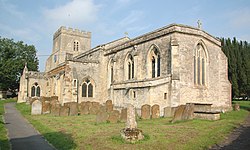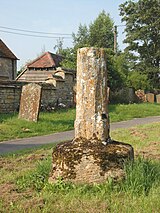Ambrosden
| Ambrosden | |
| Oxfordshire | |
|---|---|
 St Mary the Virgin parish church | |
| Location | |
| Grid reference: | SP605195 |
| Location: | 51°52’16"N, 1°7’17"W |
| Data | |
| Population: | 2,248 (2011) |
| Post town: | Bicester |
| Postcode: | OX25 |
| Dialling code: | 01869 |
| Local Government | |
| Council: | Cherwell |
| Parliamentary constituency: |
Banbury |
| Website: | Ambrosden Parish Council |
Ambrosden is a village in Oxfordshire, found three miles south-west of Bicester to which it is linked by the A41 road, and thirteen miles from Oxford. The 2011 Census recorded the parish's population as 2,248.
To the south runs the River Ray to the south and to the west its tributary the River Bure. Two miles to the west is the site of Alchester Roman Town. Three bridges cross the River Ray in the parish: Heath Bridge and Arncott Bridge, and Blackthorn Bridge. Arncott Bridge, on the road between Arncott and Ambrosden, is a five-arched bridge built in the 18th century.[1]
Ambrosden has a Church of England parish church and a public house. Since the Second World War, Ambrosden has housed Army personnel stationed at St. George's Barracks, which is at Arncott about a mile and a half south of Ambrosden. The Ministry of Defence had many new houses built at Ambrosden in the early 1950s.[1]
Name
In the 19th century it was believed that the toponym "Ambrosden" came from a diminutive derivative of the name Ambrosius Aurelianus, a 5th-century British commander of whom Gildas wrote, and that the commander had encamped close the present site of Ambrosden to help the neighbouring military garrison at Alchester in conflicts with the Anglo-Saxons.[1][2] The word don or den, an Old English word meaning "a place on a hill or ascent", was added as a suffix. Thus, a Roman name and an English syllable may have been combined as "Ambrosden".
This interpretation, however, has been rejected by historians who believe the toponym was derived not from Ambrosius, but from the Old English for "Ambre's hill";[1][2] unless of course 'Ambre' was indeed Ambrosius. The forms Ambresdone, Ambresden, or Aumbresden were all recorded in the Middle Ages.[1]
History
The course of Akeman Street, the Roman road, which linked Watling Street with the Fosse Way, passes through the parish less than half a mile north of the village. Roman pottery has been found in the area. When the scholar and antiquarian White Kennett was Vicar of Ambrosden (from 1685 to 1708), ancient Danish remains were found in the parish.[1]
During the reign of King Edward the Confessor a lady called Elviva (probably a Latin rendering of the Old English name Ælfgifu), held the manor of Ambrosden. The Domesday Book records that by 1086 she had been replaced by Hugh d'Ivry, butler of William the Conqueror and brother of Roger d'Ivry, who owned several manors in Oxfordshire. Hugh's nephew Roger II d'Ivry inherited Ambrosden and by 1194. In 1288, Edmund, 2nd Earl of Cornwall, gave the manor to Ashridge Priory of the Augustinian order of the Brothers of Penitence. Ashridge Priory retained Ambrosden until the priory was dissolved in 1539 in the Dissolution of the Monasteries.[1]
In 1542, the Crown granted Ambrosden to John Denton of Blackthorn, Oxfordshire. In 1604, Edward Denton sold the manor to Margaret Whethill of London, married a recusant, Sir Thomas Mildmay. The estate was confiscated by Parliament from their grandson, a Royalist in the Civil War, and sold. During that war, the area was occupied in June 1643, when part of the King's forces were at Bicester and guarded Blackthorn Bridge.[1]
A landscaped park with lakes and statues was laid out around the house, and the drive to the house was along a semicircular avenue of trees. Sir Edward died in 1766. Sir Gregory Page-Turner, 3rd Baronet considered the house too large, so in 1767 he sought to demolish part of it to create a smaller house. This proved impossible so in 1768 he had the entire house demolished.[1]
Parish church
The earliest part of the Church of England parish church of St Mary the Virgin is the 12th-century Norman north doorway. The Early English Gothic west tower was built slightly later.[3] The south aisle was added in the 14th century and the chancel was rebuilt in the 15th century with Perpendicular Gothic traceried windows.[4]
The church plan, as existed and as chronicled in 1823 records, and in possession of John Wayland, esq. of Woodeaton, had a large courtyard entered through two elegant gates with a cross fixed at the northern part. The southern end of courtyard also had a cemetery. The main church building comprised:[5]
... an embattled tower of two stories, with a vane at each angle; a nave, a chancel, and a south aisle; the latter crowned with a parapet, pierced with trefoils and supported by three handsome buttresses, ornamented with niches, once containing statues of saints.
The nearby vicarage dates from 1638.[3] The Reverend White Kennett (1660–1728) was vicar of Ambrosden from 1685 until 1708.[1] During his incumbency, Kennett became tutor and vice-principal at St Edmund Hall, Oxford and published a number of scholarly works. Kennett was also Rector of St Botolph's Aldgate in London from 1700, Archdeacon of Huntingdon from 1701 and Dean of Peterborough from 1707.
Outside links
| ("Wikimedia Commons" has material about Ambrosden) |
References
- ↑ 1.0 1.1 1.2 1.3 1.4 1.5 1.6 1.7 1.8 1.9 A History of the County of Oxford - Volume 5 pp 15-30: @ (Victoria County History)
- ↑ 2.0 2.1 Dunkin 1823, p. 2
- ↑ 3.0 3.1 Nikolaus Pevsner: The Buildings of England: Oxfordshire, 1974 Penguin Books ISBN 978-0-300-09639-2page 422
- ↑ National Heritage List 1046525: Church of St Mary the Virgin (Grade II* listing)
- ↑ Dunkin 1823, pp. 4–6

